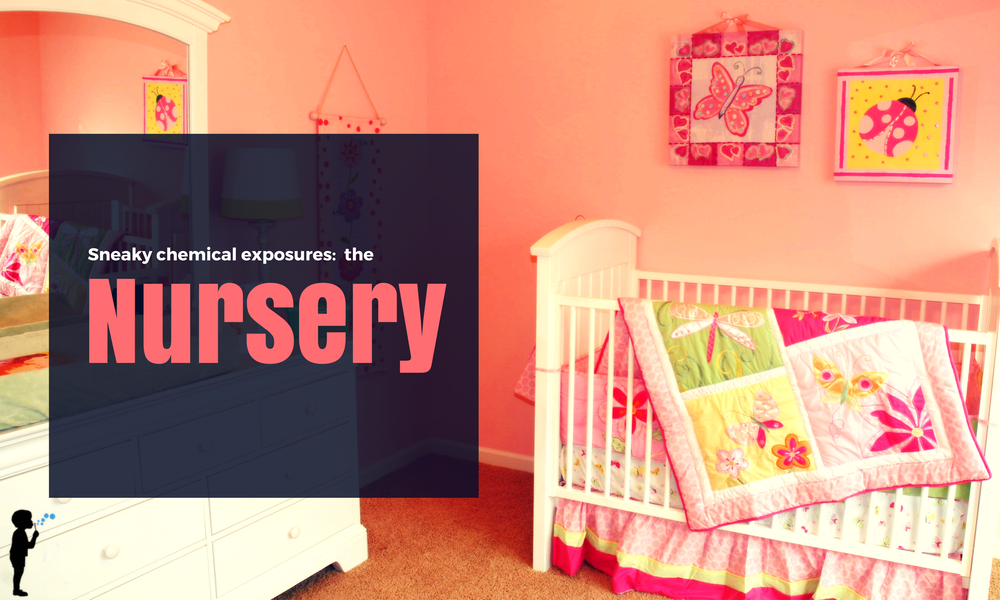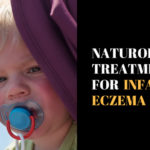
Sneaky Chemical Exposures: the Nursery
Baby’s on the way. You’re busy nesting. Painting the nursery, buying the crib, the dresser, the glider, the toy chest. It’s an exciting time. But the hundreds of decisions that have to be made regarding exactly what to buy can be stressful. Well, add another stressor: between flame retardants, formaldehyde-laced particle board, and volatile organic compounds (VOCs) in paint, you have a lot of chemicals to try to block at the door of baby’s room.
Paint
VOCs are what gives paint that terrible chemical smell. The EPA lists the following as side effects of exposure to VOCs: “eye, nose, and throat irritation; headaches, loss of coordination, nausea; damage to liver, kidney, and central nervous system, as well as cancer. Granted, the health effects of VOCs vary by specific compound (some compounds are not known to have any side effects) and by length and route of exposure to the compound(s). Pregnant women and young children may be especially sensitive to VOCs. You can find more information on VOCs here and here.
Fortunately, paint has come a long way. There are now plenty of low- and no-VOC paints on the market. Taking the VOCs out not only means your house doesn’t stink to high heaven while you’re painting and for days afterward, but also that you and your family are not sucking in hazardous chemicals all day and night. These paints vary in price, just as high-VOC paints do, and are not necessarily more expensive. Quality and performance can vary, just as they do with high-VOC paints. So you’ll want to research these matters. Also, there doesn’t seem to be a lot of oversight to the industry, and it seems some low- or zero- VOC paints do still put out that smell, leaving me to wonder if they are mislabeled. So you’ll need to research that as well. When you’re painting the room baby will spend half of his life in, it’s time well spent.
Furniture
Flame retardants and formaldehyde are the big ones to be aware of here. Exposure to both has been linked to serious health problems.
Flame Retardants are found in upholstered furniture, mattresses, carpet, and children’s items such as car seats, changing pads, infant sleep positioners, nursing pillows and strollers.
The following list references those problems that have been directly studied and shown to be linked to flame retardant exposure:
- Thyroid problems in pregnant women
- Depression of learning and memory (rat study)
- Attention span, cognition, fine motor development, lower IQ
- Advanced puberty
- Neurotoxicity
- Cancer: see this NCBI report and this report from the California EPA; or this study on abnormal pap smears
Formaldehyde is found in composite woods including MDF, plywood, and particle board; paneling; and some insulation.
The following list references those problems that have been directly studied and shown to be linked to formaldehyde exposure:
- Asthma
- Eye, nose, throat irritation, Bronchitis
- Possible menstrual disorders
- Possible cancer: see this EPA report and this National Cancer Institute report
Other
Unfortunately, a blog on home safety would not be complete without a discussion of lead, radon, and air freshener.
Lead is found in the paint of old homes (pre 1978). It can also be found in your soil, if the outside of your home was ever scraped or sanded improperly. Most landlords tend to gloss over the lead clause of their leases, saying something like, “don’t lick the walls.” There are two problems with this attitude. One is that if you live with kids, they just might lick the walls, and eat the paint chips. The other is that lead turns to dust easily. That dust falls to the furniture and floor. Your children then end up with that dust on their hands and lick them. Also, everyone breathes in the dust. Lead is the most problematic where paint is chipping and where doors or windows rub against wood frames causing lead paint to turn to dust. If you have lead in your soil outside, your children may play in the dirt and thereby ingest it, or you may grow edible plants that may absorb it.
Lead exposure in children can lead to decreased IQ; neurotoxicity; behavioral problems; anemia; liver and kidney problems; hearing problems; developmental problems; and in extreme cases, even death. It can cause a multitude of problems in adults as well. See more from the US EPA.
Radon is found in some homes and causes cancer. It’s quite easy to test for and can be an easy problem to fix. See more from the US EPA.
According to the National Resources Defense Council (NRDC), air freshener may contain allergens, VOCs, and phthalates. A study done by UC Berkeley found other harmful chemicals, as well as some which may be benign on their own, but react when sprayed to form such chemicals as formaldehyde. Phthalates are associated with reproductive and fertility problems, possible insulin problems, possible weight gain and possible cancer.
Action
So what can you do to decrease your child’s exposure?
- Buy zero-VOC paint from a reputable source
- Don’t buy composite woods
- Buy products known to be free of unnecessary chemicals
- There’s not a lot of regulation here, so an “organic” or “natural” label may not mean it’s 100% safe
- Buy products from a reputable source, or those that have been studied and proven safe
- Check out Healthy Child for further guidance
- Vacuum frequently with a HEPA filter
- Wash hands frequently, especially before eating
- Damp clean floors and surfaces frequently
- Test your paint, inside and out, for lead
- Test your soil for lead (note that this is controversial, and can lead false negative results)
- Avoid the use of air fresheners, even those labeled “natural”
For more information:
Surprising Health Hazards in Your Home
Flame Retardants are Everywhere
Four Lessons About Formaldehyde
Furniture and Flame Retardants
Science Daily on Air Fresheners

